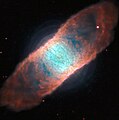IC 4406
| Emission nebula | |
|---|---|
| Planetary nebula | |
 Hubble Space Telescope view of IC 4406 | |
| Observation data: J2000 epoch | |
| Right ascension | 14h 22m 26.278s[1] |
| Declination | −44° 09′ 04.35″[1] |
| Distance | 2.0 kly (600 pc)[2] ly |
| Constellation | Lupus |
| Physical characteristics | |
| Absolute magnitude (V) | -0.3 |
| Notable features | - |
| Designations | Retina Nebula[3] |
IC 4406, sometimes known as the Retina Nebula,[4] is a planetary nebula near the western border of the constellation Lupus, the Wolf. It has dust clouds and has the shape of a torus. Despite this, it looks somewhat rectangular because it is seen from its side as viewed from Earth, almost in the plane[2] of its equator.
Structure[]
IC 4406 is bipolar and appears to be a prolate spheroid with strong concentrations of material in its equator.[3] This kind of structure is a natural product of a bipolar model.[3] The knots of IC 4406 have a "lacy" appearance and have no ordered symmetry towards the central star.[2] The knots have no tails.[2] None of the features have bright edges.[2]
The central star of the planetary nebula has a spectral type similar to that of a Wolf–Rayet star.[5] An analysis of Gaia data suggests that it may be a binary system.[6]
Gallery[]

IC 4406 seen with MUSE instrument and the Adaptive Optics Facility.[7]
See also[]
References[]
- ^ a b "SIMBAD Astronomical Database". Results for IC 4406. Retrieved 2006-12-19.
- ^ a b c d e O'dell, C. R.; Balick, B.; Hajian, A. R.; Henney, W. J.; et al. (2003). "Knots in Planetary Nebulae". In S. J. Arthur & W. J. Henney (ed.). Revista Mexicana de Astronomía y Astrofísica (Serie de Conferencias). Winds, Bubbles, and Explosions: a conference to honor John Dyson, Pátzcuaro, Michoacán, México, September 9–13, 2002. Vol. 15. pp. 29–33. Bibcode:2003RMxAC..15...29O.
- ^ a b c O'Dell, C. R.; Balick, B.; Hajian, A. R.; Henney, W. J.; Burkert, A. (2002). "Knots in Nearby Planetary Nebulae". The Astronomical Journal. 123 (6): 3329–3347. Bibcode:2002AJ....123.3329O. doi:10.1086/340726.
- ^ Chadwick, Stephen; Cooper, Ian. Imaging the Southern Sky. Springer. p. 149. ISBN 1461447496.
- ^ González-Santamaría, I.; Manteiga, M.; Manchado, A.; Ulla, A.; Dafonte, C.; López Varela, P. (2021). "Planetary nebulae in Gaia EDR3: Central star identification, properties, and binarity". Astronomy & Astrophysics. 656: A51. arXiv:2109.12114. Bibcode:2021A&A...656A..51G. doi:10.1051/0004-6361/202141916. S2CID 237940344.
- ^ Chornay, N.; Walton, N. A.; Jones, D.; Boffin, H. M. J.; Rejkuba, M.; Wesson, R. (2021). "Towards a more complete sample of binary central stars of planetary nebulae with Gaia". Astronomy & Astrophysics. 648: A95. arXiv:2101.01800. Bibcode:2021A&A...648A..95C. doi:10.1051/0004-6361/202140288. S2CID 230770301.
- ^ "Cutting-edge Adaptive Optics Facility Sees First Light - Spectacular improvement in the sharpness of MUSE images". www.eso.org. Retrieved 4 August 2017.
External links[]
 Media related to IC 4406 at Wikimedia Commons
Media related to IC 4406 at Wikimedia Commons
- Planetary nebulae
- Lupus (constellation)
- IC objects
- Nebula stubs
